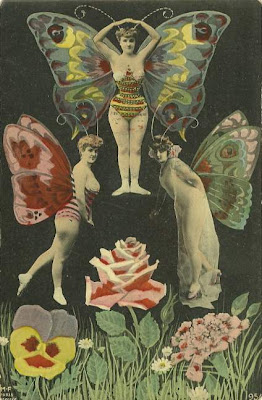"By the early twentieth century, convergent Russian and Japanese imperial ambitions in the Far East reached the boiling point over Manchuria. In February 1904 Japan attacked and sank much of the Russian Pacific Fleet anchored off Port Arthur. Weakened by successive and humiliating defeats that helped spawn the 1905 revolution, the Russians accepted U.S. President Theodore Roosevelt’s offer of mediation, as did the exhausted Japanese. Representatives of the two sides met in Portsmouth, New Hampshire in September 1905, where they signed the Treaty of Portsmouth. Under the terms of the agreement, Russia was forced to give up many of its earlier gains in Manchuria and the Far East." -
Library of Congress
Side View of Temple Building with Red Sky Background

Balloon with Japanese Flag in the Sky

Sinking Russian Naval Boat

Red Explosion Motif and Silver Lines

Rising Sun, Cherry Blossoms, and Eagle

Danger Off Port Arthur

The Fall of the Variag

Letter from the Front

Nurse and Soldiers

Nurse Looking Over a Wounded Soldier

School Girls' Banzai

News Runners Rushing in with the Latest

Newspaper Man Rushing in the Latest

Newboys in Fight

Newsboy Selling Extras

Crowds Gathering to Read the News (by Hashimoto Kunisuke)

Children Holding Japanese and Russian Flags

Sailor
-
"The Russo-Japanese War coincided with the emergence of picture postcards as a global phenomenon. Photographers, artists, illustrators, flat-out propagandists—all suddenly possessed, in these engaging little mass-produced graphics, a new vehicle for reaching a huge popular audience.
International postal conventions made it possible to circulate these images globally. Collecting postcards became a modest way to become cosmopolitan without much expense, and the war between Japan and Russia provided the first dramatic international spectacle for postcard manufacturers to focus on in common. Admiral Tōgō’s surprise attack triggered a postcard boom—not just in Japan but around the world.
This new mode of expression attracted many of the nation’s talented artists, including some who were or would become well known. The postcards themselves became ephemeral little works of art as well as little gems of propaganda.
This makes Japanese postcards of the Russo-Japanese War interesting in their own right, but this is just the half of it. Because Russia was also producing postcards of the war, and not only Russia but also France, England, Germany, Italy, and the United States, the great “war in the Far East” of 1904-1905 is the first modern war we can revisit, in a compact and manageable way, from a truly multi-national perspective.
We can literally “see,” through thousands of fixed-format images (postcards have remained the same size to the present day), what people throughout the world were being offered as a mirror to the war and all that it portended." -John W. Dower, MIT's Visualizing Cultures [
link]
-
all of these come from MIT's beautiful Visualizing Cultures collections [
link]
also see the accompanying collection
Yellow Promise / Yellow Peril, a collection of foreign postcards from the war [
link]
another related collection of woodblock prints from the war [
link]
an essay by John W. Dower about the war and these postcards (with more postcards) [
link]
for more information and resources on the war visit the impressive Russo-Japanese War Research Society website [
link]
LOC's Russian-Japanese Relations in the Far East [
link]
Strange Maps Russo-Japanese War Cartoons post [
link]
About Postcards post Russo-Japanese War Military Propaganda Postcard [
link]






